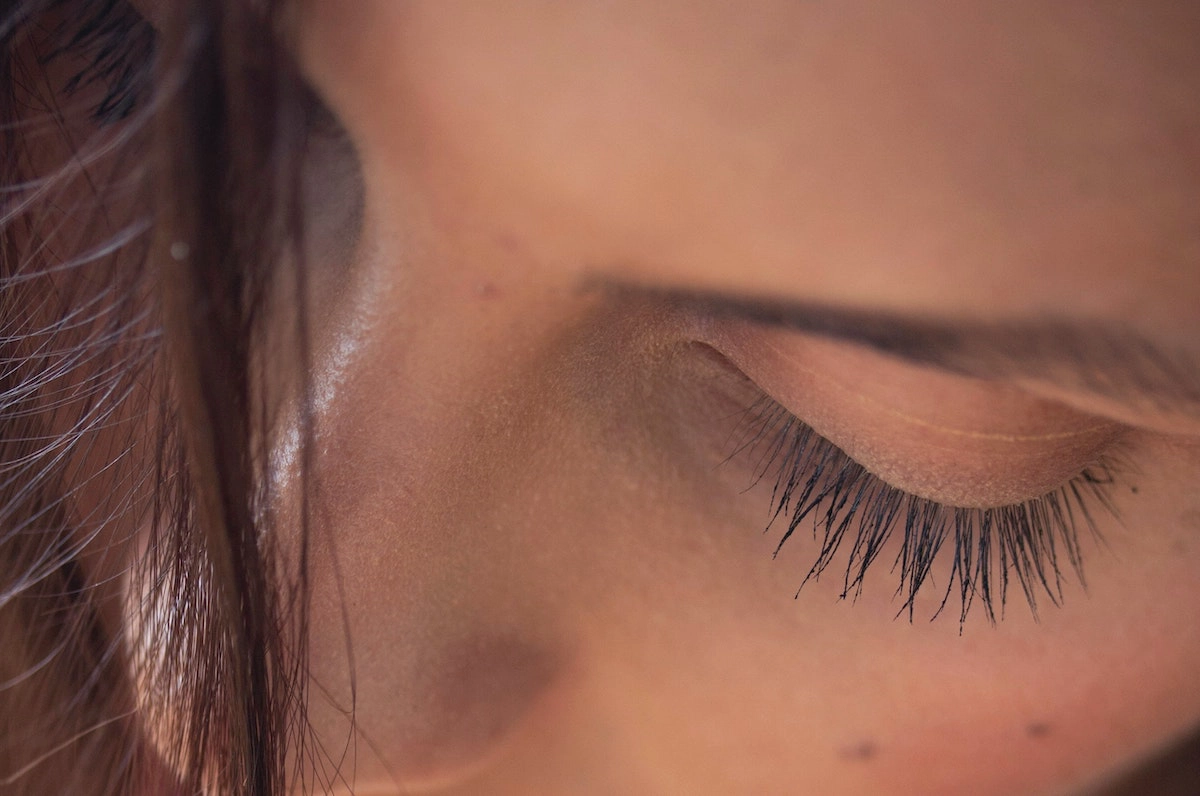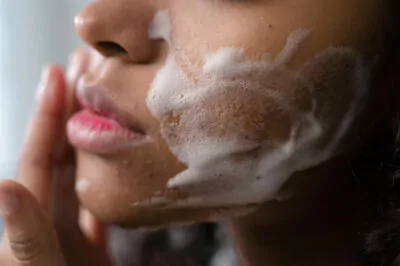Table of Contents[Hide][Show]
Part 3: Mistakes in Frequency & After-Care+−
- Mistake #9: Rubbing Your Face Dry
- Mistake #10: Waiting Too Long to Apply Your Next Products
- Mistake #11: Over-Cleansing Your Skin
- Mistake #12: Skipping the Morning Cleanse
- Mistake #13: Using Makeup Wipes as a Cleanser
- Mistake #14: Using an Exfoliating Scrub as Your Daily Cleanser
- Mistake #15: Forgetting Your Neck and Décolleté
- A Journey of Small, Powerful Changes
- Frequently Asked Questions
You cleanse your face every single day, maybe even twice a day, but are you still dealing with persistent dryness, excess oil, or a frustrating lack of radiance? It’s a common story. You might have the most beautiful, potent serums and moisturizers waiting on your shelf, but their effectiveness is dramatically reduced if the very first step of your routine is accidentally working against you.
What if the small, seemingly insignificant habits in our daily cleansing routine are the real culprits behind our biggest skin frustrations? And what if correcting them is the simplest, most powerful key to unlocking a truly healthy, balanced, and glowing complexion?
This guide will walk you through 15 of the most common cleansing mistakes we see as estheticians. Don’t feel overwhelmed; think of this as your definitive, gentle checklist to transform your cleansing step from a potential source of damage into a powerful, supportive ritual for your skin.
Part 1: Mistakes in Preparation & Product Choice
A flawless cleanse begins long before the water starts running. Using the wrong tools, the wrong temperature, or even the wrong cleanser for your skin’s needs can set your routine up for distress from the very start. Let’s explore the most common missteps in this crucial preparatory phase.
Mistake #1: Using a Harsh, Stripping Cleanser

The desire for that “squeaky clean” feeling is a common and understandable trap. However, that sensation often signals that your cleanser may be too strong for your skin’s natural balance. Harsh detergents like sulfates are so powerful that they can’t distinguish between unwanted buildup and the natural oils that help keep your skin feeling hydrated and comfortable. Over time, this can leave your skin feeling tight, dry, or more reactive. A great cleanse should leave your skin feeling soft and refreshed — never stripped.
Mistake #2: Washing with the Wrong Water Temperature
The hot vs. cold water debate is a major point of confusion. The truth is that both extremes aren’t ideal for your skin. Think of it this way: hot water can behave like a solvent, washing away the natural lipids that help keep your skin feeling comfortable and balanced. On the other hand, cold water can make oils on the surface more solidified, making them harder for your cleanser to effectively rinse away. Lukewarm water is the ideal middle ground — warm enough to help soften buildup, yet cool enough to respect your skin’s natural balance.
Mistake #3: Not Washing Your Hands First
This one is simple but often overlooked. Throughout the day, your hands naturally pick up oils and debris from everything you touch. Applying cleanser with unwashed hands can transfer that buildup back onto your skin, making it harder to achieve a truly clean feel. Taking a moment to wash your hands first ensures you’re starting your cleansing ritual with a fresh foundation, helping your skin feel refreshed and cared for.
Mistake #4: Relying on a Single Cleanse to Remove Makeup & SPF
Modern makeup and, most importantly, sunscreens are designed to be long-wearing and water-resistant. Because of this, a single wash with a traditional cleanser often isn’t enough to fully remove these oil-based layers. That’s where the wisdom of double cleansing comes in — not as an indulgence, but as a simple way to ensure a thorough, balanced cleanse.
Starting with an oil-based cleanser, like our Restorative Cleansing Oil, helps to gently loosen and lift oil-based buildup such as makeup, sunscreen, and daily residue. Follow with one of our aloe-based cleansers, such as the Aloe Herb Cleanser, Citrus Mint, or Phytonutrient Cleanser, to leave your skin feeling fresh, soft, and comfortable — never stripped. Together, they create a mindful ritual that supports your skin’s natural balance.
Part 2: Mistakes in Technique & Application

Once you have the right cleanser and have set the stage, your technique is what makes all the difference. This is where you transform a surface-level rinse into a truly effective, transformative cleanse. How you touch your skin and the time you dedicate to the process are paramount.
Mistake #5: Rushing the Process (The 10-Second Wash)
This is perhaps the most common mistake of all. A quick splash-and-dash doesn’t give your cleanser’s ingredients enough time to fully emulsify and lift away the day’s buildup. For the best results, take a full 60 seconds to gently massage your cleanser into your skin. This isn’t just about getting cleaner skin; this dedicated minute transforms the step from a chore into a mindful facial massage that helps support the skin’s natural rhythm, promoting a refreshed, radiant appearance.
Mistake #6: Cleansing Too Aggressively
Many of us scrub our skin under the false assumption that more pressure equals a deeper clean. In reality, your cleanser — and that 60-second timeframe — should do all the heavy lifting. Applying too much pressure doesn’t make your skin cleaner; it simply creates unnecessary friction that can leave it feeling uncomfortable or more reactive. The golden rule is to trust the process, not the pressure. Use gentle, circular motions with your fingertips and let the formula do its work.
Mistake #7: Missing Key Areas
When we’re in a hurry, it’s easy to give a quick wash to the main planes of our face—cheeks, chin, and forehead—and call it a day. But impurities, sweat, and product residue love to accumulate in often-forgotten places. To prevent the hidden congestion that can lead to clogged pores, make a conscious effort to cleanse thoroughly along your hairline (where hair products settle), around the sides of your nose (where oil often gathers), and down your jawline and neck (where makeup and SPF often end).
Mistake #8: Using a Dirty Washcloth or Brush
This mistake can undo all of your hard work in an instant. A damp washcloth or an unrinsed brush head left in a warm, humid bathroom can easily collect buildup from previous use. When you reuse these tools, you may be transferring that residue back onto newly cleansed skin, diminishing the feeling of a fresh finish. Always reach for a soft, dry towel or clean cleansing brush each time you cleanse to keep your skin feeling comfortable and well cared for.
Part 3: Mistakes in Frequency & After-Care

The ritual doesn’t end the moment you rinse. What you do immediately after washing your face—and how often you perform the cleanse itself—is just as crucial for maintaining a healthy, balanced, and resilient skin barrier.
Mistake #9: Rubbing Your Face Dry
After such a gentle cleansing process, the last thing you want is a moment of unnecessary aggression. Vigorously rubbing your face with a rough towel creates friction, which can disturb the freshly cleansed surface and leave your skin feeling uncomfortable. The esthetician-approved method is to gently pat your skin dry with a soft, clean towel, leaving a hint of dampness on the surface.
Mistake #10: Waiting Too Long to Apply Your Next Products
There is a “golden window” of about 60 seconds after patting your skin dry. During this time, your skin is slightly damp and freshly cleansed, creating the ideal surface for hydration. Waiting too long allows moisture to begin evaporating through a natural process known as transepidermal water loss (TEWL). Applying your toning mist, serum, or moisturizer within this window helps support hydration and keeps your skin feeling soft and comfortable.
Mistake #11: Over-Cleansing Your Skin
In skin care, more is not always better. For most skin types, cleansing more than twice a day can be unnecessarily harsh and may disrupt the skin’s natural protective barrier. This can start a frustrating cycle of dryness or surface irritation, and may even leave skin looking oilier as it tries to rebalance. Trust that a thorough morning and evening cleanse is all you need for skin that feels clean and comfortable.
Mistake #12: Skipping the Morning Cleanse
It’s a common myth that your skin is perfectly clean when you wake up. Overnight, your skin naturally goes through renewal—shedding dead surface cells, producing oil, and releasing perspiration. A gentle morning cleanse helps remove this buildup and leaves a clean, balanced canvas for your daytime products and, most importantly, your sunscreen.
Mistake #13: Using Makeup Wipes as a Cleanser
This is a hard truth: makeup wipes do not cleanse your skin. They primarily smear a mixture of makeup, oil, and impurities across your face without truly removing it. Furthermore, they often leave behind a residue of preservatives and surfactants that can be irritating and contribute to congestion. Think of them as a last resort for emergencies only, not as a part of a healthy, daily cleansing ritual.
Mistake #14: Using an Exfoliating Scrub as Your Daily Cleanser
A cleanser’s job is to clean. An exfoliator’s job is to resurface. Confusing these two distinct roles can disrupt your skin’s natural balance. Using a gritty, physical scrub as your daily cleanser creates repeated surface friction that can leave skin feeling dry, sensitive, or irritated over time. Save your exfoliants for a once-or-twice-weekly treatment.
Mistake #15: Forgetting Your Neck and Décolleté
Your skin care routine should never stop at your chin. The neck and chest (décolleté) are exposed to the same environmental stressors and UV rays as your face and are often among the first areas to show visible changes in texture and tone. Extending your cleanse—and the rest of your routine—all the way down is a crucial step for maintaining a smooth, even, and well-cared-for appearance over time.
A Journey of Small, Powerful Changes
After reading a list like this, it’s easy to feel overwhelmed. But the goal isn’t immediate perfection, it’s mindful progress. By correcting even a few of these common, unintentional mistakes, you can fundamentally transform your cleansing routine from a potential source of stress into a powerful act of support for your skin’s barrier.
We encourage you to choose just one or two mistakes from this list that resonate with you and focus on turning them into healthy new habits. A beautiful, effective cleanse is the foundation upon which your entire routine is built. Get this step right, and you allow every other product you use to perform its best.
After perfecting your cleanse, the next step is to replenish and protect. A nourishing cream like our Restorative Facial Cream provides deep comfort, while a targeted facial oil like our Anti-Aging Facial Oil or Rejuvenating Facial Oil can deliver a truly radiant glow. We invite you to explore our full Facial Oils collection to find the perfect nourishment for your unique skin.
Frequently Asked Questions
How can I tell if my current cleanser is too harsh?
The tell-tale sign is how your skin feels immediately after rinsing. If you experience a feeling of tightness, dryness, or a “squeaky clean” sensation, that’s your skin signaling that its protective barrier has been stripped. A healthy, happy cleanse should leave your skin feeling soft, calm, and comfortable.
Is double cleansing necessary every single night?
It is highly recommended on any day you wear makeup or sunscreen, as it’s truly the most effective way to remove those products thoroughly. On bare-faced days when you’ve stayed indoors, a single, thorough 60-second cleanse with your water or aloe-based cleanser may be sufficient. Listen to your skin’s needs for the day.
What should I apply to my skin right after cleansing?
Immediately after patting your skin dry is the “golden window” to apply your most potent, targeted treatments. This is directly related to understanding the key differences between a facial oil and a serum and which one will best serve your skin’s needs in that moment.







Leave a Reply